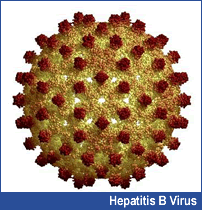By
Liz Highleyman
 Several
directly-targeted antiviral agents are used to treat chronic
hepatitis B. Long-term therapy is typically required, but
the virus can develop resistance to individual drugs used
alone, thereby compromising effectiveness over time. Some
newer agents, however, have a higher barrier to resistance
than earlier drugs such as lamivudine
(Epivir-HBV).
Several
directly-targeted antiviral agents are used to treat chronic
hepatitis B. Long-term therapy is typically required, but
the virus can develop resistance to individual drugs used
alone, thereby compromising effectiveness over time. Some
newer agents, however, have a higher barrier to resistance
than earlier drugs such as lamivudine
(Epivir-HBV).
Andrea
Snow-Lampart from Gilead Sciences and colleagues analyzed
long-term data from 2 Phase 3 clinical trials comparing
300 mg once-daily tenofovir versus 10 mg once-daily adefovir
(Hepsera) in chronic hepatitis B patients. Study 102
included 375 hepatitis B "e" antigen (HBeAg) negative
participants and Study 103 included 266 HBeAg positive patients.
Some participants in both studies were previously untreated
while some had previously used lamivudine.
After
48 weeks of randomized treatment, 93% of HBeAg negative
patients and 76% of HBeAg positive patients achieved complete
viral load suppression (> 400 copies/mL). At that
point, eligible participants in both arms could receive
open-label tenofovir with no treatment interruption. Participants
who still had detectable HBV DNA at or after week 72 had
the option of adding emtricitabine
(Emtriva) to tenofovir (the 2 drugs in the Truvada
combination pill approved for HIV treatment), but only 5%
did so.
The
researchers performed genotypic analysis to look for resistance-associated
HBV polymerase/reverse transcriptase (pol/RT) mutations,
and conducted phenotypic resistance testing using HepG2
laboratory cells infected with HBV obtained from patient
serum.
All
participants received a genotypic test at baseline. Those
who still had detectable HBV on tenofovir monotherapy at
week 144 (34 in the continuous tenofovir arm and 19 who
were originally randomized to adefovir and switched to open-label
tenofovir), or after adding emtricitabine (7 and 5, respectively),
were tested again.
Researchers
plan to continue this study for 8 years, and it is now at
about the halfway point. In the recent Hepatology article,
Snow-Lampart's team reported combined data from Study 102
and 103 through week 144, or about 3 years.
Results
 |
At
week 144, no participants developed amino acid substitutions
(mutations) known to be associated with resistance to
tenofovir. |
 |
The
researchers identified 6 previously undescribed HBV
pol/RT mutations, but none of these appeared to cause
tenofovir resistance according to phenotypic testing. |
 |
Virological
breakthrough while on tenofovir monotherapy was infrequent,
occurring in just 13 out of 426 patients (3%). |
 |
Viral
rebound was attributed to documented non-adherence in
11 of these patients (85%). |
 |
Detectable
HBV viral load (> 400 copies/mL) was rare
through week 144, occurring in only 5 out of 641 patients
(0.8%). |
 |
Continued
HBV viremia was not associated with resistance to tenofovir. |
Based
on these findings, the study authors concluded, "No
nucleoside-naive or nucleoside-experienced patient developed
HBV pol/RT mutations associated with [tenofovir] resistance
after up to 144 weeks of exposure to [tenofovir] monotherapy."
In
a follow-up analysis presented at the American Association
for the Study of Liver Diseases (AASLD) "Liver Meeting"
this past fall, Snow-Lampart and colleagues reported
data from 196 weeks, or about 4 years, indicating that
most patients on tenofovir still maintained viral suppression
and none showed evidence of resistance mutations.
In
comparison, the researchers noted, prior studies have shown
that as many as 70% of patients develop resistance to lamivudine
after 4 years, nearly one-third showed resistance after
5 years on adefovir, 25% of HBeAg positive and 11% of HBeAg
negative patients did so after 2 years on telbivudine
(Tyzeka), and just over 1% did so after 5 years on entecavir
(Baraclude).
Investigator
affiliations: Gilead Sciences, Durham, NC; Gilead Sciences,
Foster City, CA; University of Toronto, Toronto, Ontario,
Canada; Hospital Beaujon, University of Paris, Clichy, France.
1/7/11
Reference
A Snow-Lampart, B Chappell, M Curtis, and others. No
resistance to tenofovir disoproxil fumarate detected after
up to 144 weeks of therapy in patients monoinfected with
chronic hepatitis B virus. Hepatology (Abstract).
December 22, 2010 (Epub ahead of print).
Other
Citation
A
Snow-Lampart, KM Kitrinos, BJ Chappell, and others. No resistance
to tenofovir disoproxil fumarate (TDF) detected following
up to 192 weeks of treatment in subjects mono-infected with
chronic hepatitis B virus. 61st Annual Meeting of the American
Association for the Study of Liver Diseases (AASLD 2010).
Boston, October 29-November 2, 2010. Abstract 1365.
